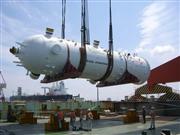Management:
Japanese three leading heavy industry
companies – Mitsubishi Heavy, Kawasaki Heavy, and IHI – launched new products
one after another for diversification to maintain domestic employment after the
so-called depression on shipbuilding. They are sometimes dubbed the three
machinery department stores. Because of the please-everyone policy, they were
not able to make enough investments in promising markets and products, and they increased
interest-bearing debt dramatically. Until quite recently, they recorded a 2-3%
operating profit rate, less than half of Hyundai Heavy Industries of Korea.
Mitsubishi Heavy changed this stream. It started
to reform its business structure and introduced the “strategic business evaluation
system” in 2011. It integrated business operations and withdrew unprofitable
business operations. As a result, it reduced the interest-bearing debt from
1,600 billion yen in 2009 to 970 billion yen in the current fiscal year, less
than 1,000 billion year for the first time in the past 17 years. It will
achieve sales of 190 billion yen, which is close to the highest sales in the
past, and increase the operating profit to 6%.
The promising business field for them is the
exploration of ocean resources where they can utilize their shipbuilding
technology. The world ocean resources business field is expected to increase
two times over the current level to more than 10 trillion yen by 2020, mainly
thanks to the construction of drilling ships and offshore production facilities
of liquefied natural gas. Mitsubishi Heavy delivered four resource exploration
ships to Norway
for about 100 billion yen. Its technology to minimize the engine noise and
vibration was helpful for the successful order intake.
It is not too much to emphasize the
importance of technology. Hitachi Zosen delivered its reactor vessel to Sasol
of South Africa. A reactor vessel is the core equipment of the gas to liquid
(GTL). It is 50 m tall, and it weights nearly 200 tons. Precise welding is indispensable
to building a reactor vessel. Hitachi Zosen’s technology to bend and weld a hug
thick steel plate will allow the company to keep growing. The company dubs itself
a shipbuilding company on land. Stick to the technology that you have accumulated,
and you can open up the road for further growth.
Hitachi Zosen's reactor vessel


No comments:
Post a Comment